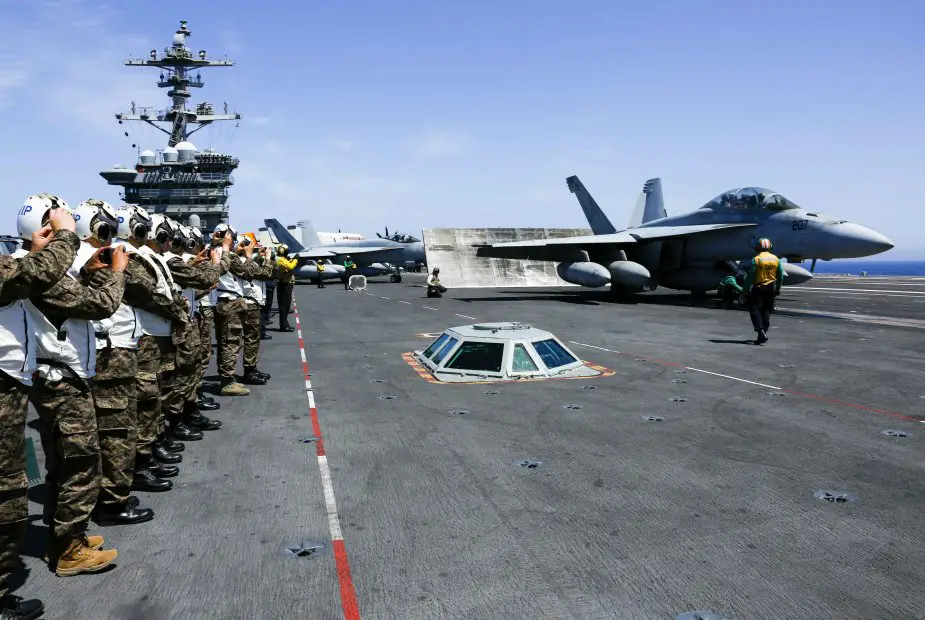Delegates of the Tunisian armed forces worked hand-in-hand with components of Carrier Strike Group (CSG) 12 in efforts to strengthen partnerships on land and at sea during a coalition exchange.
Delegates of the Tunisian armed forces worked hand-in-hand with components of Carrier Strike Group (CSG) 12 in efforts to strengthen partnerships on land and at sea during a coalition exchange.

The focus of the exchange was two-fold, involving an embark of Tunisian military leaders aboard the Nimitz-class aircraft carrier USS Abraham Lincoln (CVN 72) and joint training with Carrier Air Wing (CVW) 7.
“Tunisia is a very important partner to the African and Mediterranean regions,” Capt. William Reed, commander of Carrier Air Wing (CVW) 7, said. “It was a mutually beneficial opportunity for both of us to work together.”
During the exchange, 11 senior delegates of the Tunisian armed forces, including Tunisian Air Force Chief of Staff Brigadier General Mohamed Hajjem and Tunisian Navy Chief of Staff Rear Admiral Abderraouf Atallaha, embarked Abraham Lincoln.
The embark was particularly significant because it allowed Tunisian and American forces to gain a better understanding of the competencies each group brings to the partnership.
“I think there is a point where you’ve heard and read about it, but when you actually get to see an aircraft go into full power and take the catapult, come back around and do an arrested landing after completing its mission — it’s amazing,” Reed said. “It helps us to say we are partners, we want to work with you, and they know that we’ve got their back.”
The visit focused on military operations, aircraft maintenance and partnership building and included observing flight operations on the flight deck.
“It was an absolute pleasure to show off Abraham Lincoln to our Tunisian allies,” Lt. Osbaldo Ibarra, Lincoln’s flight deck officer who led a tour of the ship, said. “They were very professional and genuinely interested in how we operate. The time spent showing various aspects of one of the most lethal warships in the fleet was a great investment in our mutual partnership.”
The exchange also included a unique opportunity for bilateral training. Helicopter Sea Combat Squadron (HSC) 5, one of the nine squadrons of CVW 7, trained with the Tunisian air force on key missions including over land search and rescue, insertion/extraction, maintenance, corrosion control, ordnance handling procedures, and troubleshooting with aircraft avionics systems.
The collaboration brought a valued form of bilateral training to the table for HSC 5, which, while deployed at sea, was able to conduct land search and rescue training.
“What we are gleaning from it, as far as the strike group goes, is a currency and proficiency for our team to get over land — landings in the dirt that we can’t do out here (at sea),” Cmdr. Chandra Newman, HSC 5 executive officer, said. “It’s always good for a helicopter squadron to work with external assets. The fact that they have professional ground forces that we can work with adds realism and value to the training.”
With HSC 5’s primary mission being search and rescue over water, which isn’t necessarily typical for Tunisian forces, the training proved invaluable.
“We were able to show our gear and tactics for conducting night-over-water-flying, fast-roping-over-water, as well as night search and rescue to the Tunisians,” Newman said. “They were incredibly welcoming and as excited to have the training as we were excited to have that experience with them.” When developing interoperability amongst partners, building trust is a key component, according to Reed.
“During this opportunity with our Tunisian partners, we gained a better understanding of how critical it is to work with our allies in our new operating environment,” said Reed. “This is especially important with great partners like Tunisia, where we get training as well as the chance to build trust. This positions us to be even more ready to do even more next time we work together.”
Tunisian naval forces recently participated in Phoenix Express 2019, which was designed to bring together North African, European, and U.S. maritime forces as part of a global network of navies to enhance cooperation and expertise in maritime security operations. Ongoing collaboration in future iterations of Phoenix Express and other coalition exercises remains a priority for U.S. forces in the region.
“Our Tunisian allies are critical,” Reed said. “They push out stability in the region; it’s essential to have partnerships that bring that to the table.”
Abraham Lincoln is deployed as part of an ongoing rotation of forward-deployed forces in support of maritime security cooperation efforts in the U.S. 5th, U.S. 6th and U.S. 7th Fleet areas of operation. With Abraham Lincoln as the flagship, deployed strike group assets include staffs, ships and aircraft of Carrier Strike Group 12, Destroyer Squadron 2, Ticonderoga-class guided-missile cruiser USS Leyte Gulf (CG 55) and Carrier Air Wing (CVW) 7; as well as Álvaro de Bazán-class frigate ESPS Méndez Núñez (F 104).







